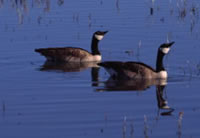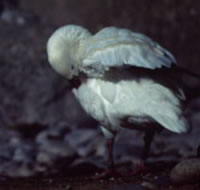 Constant
honking defines the morning commute, but the noise
has nothing to do with traffic. Instead, it is the
calls of geese lifting off from the Sloughs, the
air damp with fog and last night’s frost coating
the tamarisk. Various groups ascend from the ponds
and join those that are already in flight from the
river. Their destinations are the stubble fields,
fairways and lawns farther down the valley. Then
again, these birds may decide to push farther south
to warmer climates. Constant
honking defines the morning commute, but the noise
has nothing to do with traffic. Instead, it is the
calls of geese lifting off from the Sloughs, the
air damp with fog and last night’s frost coating
the tamarisk. Various groups ascend from the ponds
and join those that are already in flight from the
river. Their destinations are the stubble fields,
fairways and lawns farther down the valley. Then
again, these birds may decide to push farther south
to warmer climates.
I do not tire of watching these long-necked birds in
flight. Their white chinstraps give the appearance
of the birds wearing a dark helmet - safety first.
With plumb bodies and strong wings the birds gather
together in collective formations that resemble an
inverted-V, a chevron, a diagonal line or a wavy checkmark.
Their formation is not static, but dynamic as birds
shift positions or as others join the flock.
 Though
rare, there is a goose as white as snow mixed
in with these honkers from Canada. Aptly
named the “snow goose,” these
white geese have black wing tips and an alternate
form that is a mottled bluish-gray to brownish
color on the body. Not that the birds switch
color phases; the forms or morphs stay the
same throughout their lives. Though
rare, there is a goose as white as snow mixed
in with these honkers from Canada. Aptly
named the “snow goose,” these
white geese have black wing tips and an alternate
form that is a mottled bluish-gray to brownish
color on the body. Not that the birds switch
color phases; the forms or morphs stay the
same throughout their lives.
But seeing a snow goose is an unexpected pleasure in
Moab. Farther south in New Mexico, one can see thousands
of these birds along the Rio Grande River, or even
good numbers in Colorado. These birds come from the
Far North on their migration, but here in the Moab
Valley a lone snow goose is cause for celebration.
As I watch this lone goose, I am reminded of a story
by Paul Gallico. The Snow Goose is a story of friendship
that crosses physical boundaries, but it does not end
walking hand-in-hand into the sunset. The story revolves
around a lonely hermit who inhabits a lighthouse is
brought an injured snow goose by a frightened young
girl. She is not afraid of the goose, rather the hunchbacked
man with a deformed arm. The man’s gentle demeanor
and his love of painting and wild birds calm her fears.
Together they heal the goose and form an uncomfortable
bond between themselves. The snow goose, after several
migrations, returns to stay with the man at the lighthouse.
The goose and the man form a bond and the now the girl,
who has become a young woman, must struggle with her
feelings towards the man.
Unfortunately, war has broken out and the English raise
a call for help to save stranded soldiers at Dunkirk.
Though the man has only a small sailboat, he is proficient
at sailing and leaves his self-imposed exile to sail
to Dunkirk. He makes repeated forays to the beach,
dodging enemy fire, while the goose circles above calling
the soldiers to retreat. The hunchback saves many lives
that day, but loses his own to enemy gunfire. As the
rescue boats approach his small craft to retrieve his
body, the goose stands defiantly on the gunwale and
repulses all attempts to board the boat. The boat,
riddled with machine-gun fire, sinks.
The goose returns to the lighthouse and the woman intuits
the man’s fate; she senses it from the goose’s
actions. This is where the story ends and leaves us
to ponder the future of both bird and woman.
So with this story in my mind, I too wonder the fate
of this lone goose that has taken up with a different
clan. Perhaps the bird will find its own kind and leave
these “honkers” for the familiar “snowies.” Maybe
it has imprinted on the Canada geese and thinks it
is one of these geese. I hate to anthropomorphize why
and what this snow goose’s fate might be, so
I focus on just appreciating the moment and delighting
in the appearance of a lone snow goose into the Moab
Valley.

|